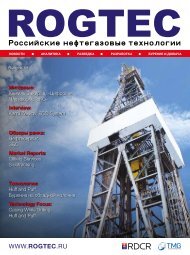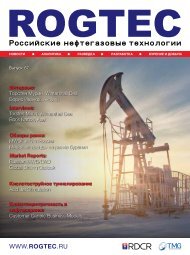ROGTEC Magazine Issue 61
Russian Oli & Gas Magazine
Russian Oli & Gas Magazine
Create successful ePaper yourself
Turn your PDF publications into a flip-book with our unique Google optimized e-Paper software.
DRILLING
горного давления и давление гидроразрыва пород,
что сужает диапазон выбора плотности буровой
промывочной жидкости (БПЖ) и приводит к
увеличению необходимого числа обсадных колонн.
Данные факторы приводят к необходимости поиска
и внедрения новых техники и технологий для
строительства морских глубоководных скважин.
Одним из перспективных направлений решения
этой проблемы является технология бурения с
регулированием дифференциального давления
(MPD – Managed Pressure Drilling) в системе
«скважина-пласт» [3]. Вариантом реализации
данной технологии, является применение системы
бурения с двойным градиентом, что открывает новые
горизонты в глубоководном бурении.
Бурение с двойным градиентом
– как одно из решений для
глубоководного бурения
При традиционной технологии бурения морской
скважины кольцевое пространство между бурильной
колонной и внутренней стенкой водоотделяющей
колонны (райзером) заполнено буровым раствором
той же плотности, что и в кольцевом пространстве
в открытом (не обсаженном) стволе скважины. Как
известно [3], плотность бурового раствора выбирается
исходя из условий создания противодавления на
горизонты, с максимальным значением пластового
давления. Эта разница между забойным и пластовым
давлением предотвращает поступление пластовой
жидкости в скважину. Однако забойное давление в
стволе скважины, должно быть меньше, чем давление
в пласте, чтобы предотвратить разрыв горных пород.
В глубоководных скважинах (например, Черное
море или Мексиканский залив) часто встречаются
пласты, имеющие узкую границу между поровым и
давлением гидравлического разрыва пласта. Этот
узкий диапазон является, как правило, результатом
Simplified Well Construction
(а)
Breakdown pressure
circulating fluids, and results in the need to increase the
number of production casing strings.
These factors lead to the necessity to search and
introduce innovative techniques and technologies for
construction of offshore deep-water wells. One of
such perspective directions to solve this problem is the
technology of Managed Pressure Drilling (MPD) in the
“well-formation” system [3]. The use of the dual gradient
drilling system is a variant of this technology, which
opens new horizons in deep-water drilling.
Dual Gradient Drilling is One of the
Deep-Water Drilling Solutions
When conventional drilling technology is applied to an
offshore well, the annulus between the drill string and
the inner wall of the riser string is filled with drilling mud
of the same weight as in the annular space of the open
(uncased) hole. As we know [3], the drilling mud weight
is selected based on the conditions for creation of uplift
pressure on horizons with the maximum formation
pressure value. This gradient between the bottomhole
pressure and the formation pressure prevents the
reservoir fluid from entering the well. The bottom-hole
pressure within the borehole, however, must be lower
than the pressure in the formation, to prevent breaking
the formation.
In deep-water wells (such as, in the Black Sea or the Gulf
of Mexico), one can often encounter horizons having a
narrow margin between the pore pressure and formation
breakdown pressure. This narrow margin is, as a rule,
the result of the abnormally high pore pressure and/or
low formation breakdown pressure, due to the fact that
the formation rock strata are additionally pressurized with
sea water, which requires a greater number of production
strings to be used in comparison with the wells of similar
depth on the continental shelf. Fig.1(a) presents the
values for production tubing string setting depth and
separation for incompatible formations.
Simplified Well Construction
(б)
Breakdown pressure
Drill mud gradient from the
surface
Pore pressure
Drill mud gradient from the
surface
Pore pressure
Depth
Seabed
Depth
Seabed
Drilling mud gradient
Target depth
Target depth
Sea water
hydrostatics
Давление гидроразрыва
Fracture Pressure
Sea water
hydrostatics
Давление гидроразрыва
Fracture Pressure
Рис.1: Графическое сравнение бурения соответственно с одним и двумя градиентами
Fig.1: Graphical comparison of the single vs. dual gradient drilling
www.rogtecmagazine.com
ROGTEC
25















